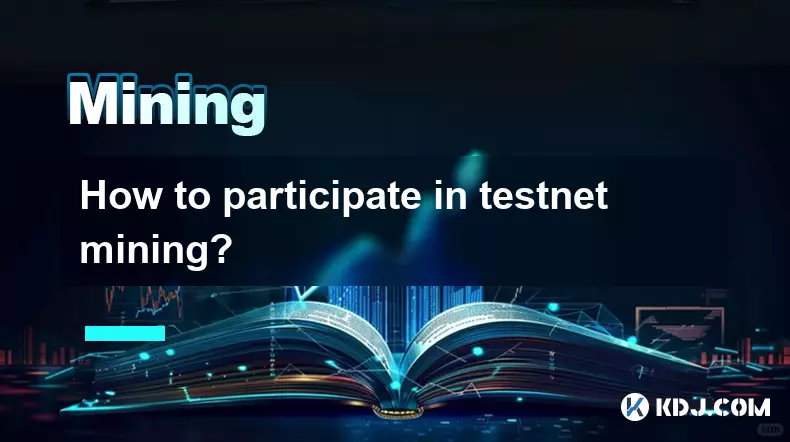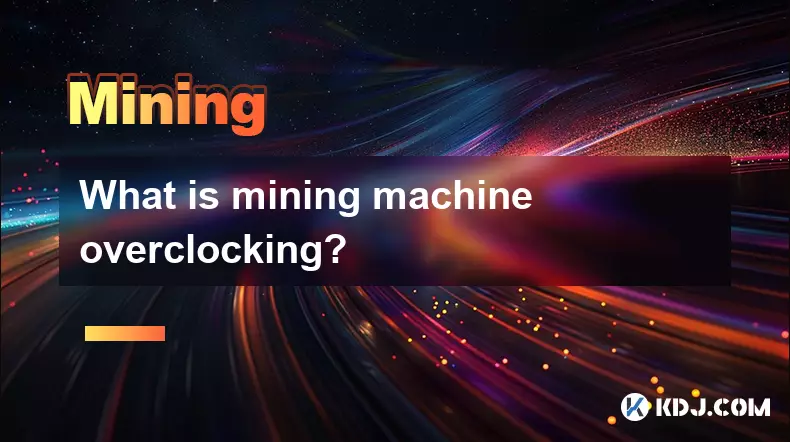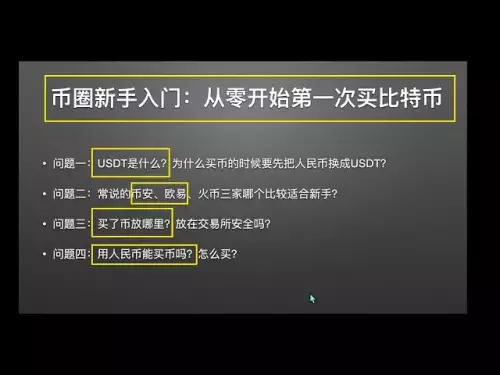-
 bitcoin
bitcoin $113137.862908 USD
0.65% -
 ethereum
ethereum $4107.436072 USD
-1.96% -
 xrp
xrp $2.908808 USD
2.59% -
 tether
tether $1.000294 USD
0.01% -
 bnb
bnb $1010.914842 USD
-1.12% -
 solana
solana $210.653310 USD
-2.16% -
 usd-coin
usd-coin $0.999776 USD
-0.01% -
 dogecoin
dogecoin $0.239360 USD
-0.04% -
 tron
tron $0.337849 USD
0.37% -
 cardano
cardano $0.807698 USD
-0.61% -
 hyperliquid
hyperliquid $45.387447 USD
0.61% -
 chainlink
chainlink $21.408287 USD
-0.92% -
 ethena-usde
ethena-usde $1.000509 USD
-0.04% -
 avalanche
avalanche $32.634682 USD
-4.77% -
 sui
sui $3.349772 USD
-0.19%
How to set up a wallet for mining?
Choose a secure, non-custodial wallet compatible with your mined cryptocurrency and integrate it with your mining software using a verified public address.
Sep 16, 2025 at 08:36 pm

Choosing the Right Wallet for Mining Operations
1. Identify the cryptocurrency you intend to mine, as different coins require specific wallet types. Bitcoin mining necessitates a Bitcoin-compatible wallet, while Ethereum mining requires an ERC-20 compatible solution.
2. Opt for wallets that support direct integration with mining pools or software. Some wallets allow automatic deposit of mined coins, reducing manual transfers and potential errors.
3. Prioritize non-custodial wallets to maintain full control over private keys. This ensures that only you can access the funds, which is critical when dealing with regular mining payouts.
4. Consider multi-currency wallets if you plan to mine various cryptocurrencies. Wallets like Trust Wallet or Exodus support a broad range of tokens and can streamline asset management.
5. Verify wallet compatibility with your mining rig’s operating system. Desktop wallets should align with Windows, Linux, or macOS environments commonly used in mining setups.
Securing Your Mining Wallet
1. Enable two-factor authentication (2FA) if the wallet platform supports it. This adds an extra verification layer during login or transaction processes.
2. Store your seed phrase offline in a secure location such as a fireproof safe. Never save it digitally or share it with anyone, as it grants complete access to your wallet.
3. Use hardware wallets like Ledger or Trezor for cold storage of mined assets. These devices isolate private keys from internet-connected systems, greatly reducing hacking risks.
4. Regularly update wallet software to patch vulnerabilities. Outdated versions may expose your funds to exploits, especially when receiving frequent transactions from mining pools.
5. Always test withdrawals with a small amount before transferring large balances. This confirms correct setup and identifies potential issues early.
Integrating the Wallet with Mining Software
1. After creating the wallet, copy the public receiving address. This address will be entered into your mining software configuration file or pool dashboard.
2. Configure your mining client (such as CGMiner or EasyMiner) to point to your wallet address. Ensure there are no typos, as incorrect addresses result in irreversible fund loss.
3. Set up automatic payout thresholds in your mining pool account. Most pools allow you to define a minimum balance before sending coins to your wallet, optimizing transaction fees.
4. Monitor the first few transactions through a blockchain explorer. Input your wallet address to verify that mined coins are being recorded on the network correctly.
5. Use static addresses instead of dynamic ones when possible. Some pools require fixed addresses to prevent misdirected payouts during mining sessions.
Best Practices for Ongoing Wallet Management
1. Separate wallets for mining and long-term storage. Use one wallet to receive daily mining rewards and another offline wallet to store accumulated holdings securely.
2. Keep detailed records of all incoming mining rewards for tax and performance tracking. Export transaction history periodically from your wallet interface.
3. Avoid connecting your mining wallet to untrusted third-party services. Phishing sites may mimic legitimate platforms and attempt to steal credentials or seed phrases.
4. Regularly audit wallet activity for unauthorized transactions. Sudden or unfamiliar movements could indicate compromised security.
5. Never disclose your wallet address publicly as a proof of balance. While addresses are public, broadcasting them may attract targeted attacks or scams.
Frequently Asked Questions
Can I use an exchange address as my mining wallet?It is not recommended. While some miners send rewards directly to exchanges for quick trading, exchange addresses are custodial and increase the risk of fund loss due to account freezes or platform vulnerabilities.
What happens if I lose my mining wallet’s private key?You will permanently lose access to all mined coins stored in that wallet. Recovery is only possible if you have a backup of the seed phrase. Always store recovery information securely and redundantly.
Do mining pools charge fees when sending to my wallet?Most pools deduct a small maintenance or service fee, typically between 1% and 3%. These fees are separate from blockchain transaction fees, which may also apply when transferring funds to your wallet.
Is it safe to keep mined coins in a software wallet long-term?Software wallets are convenient but more vulnerable than hardware options. For significant mining earnings, transfer funds to a cold wallet to protect against malware and online threats.
Disclaimer:info@kdj.com
The information provided is not trading advice. kdj.com does not assume any responsibility for any investments made based on the information provided in this article. Cryptocurrencies are highly volatile and it is highly recommended that you invest with caution after thorough research!
If you believe that the content used on this website infringes your copyright, please contact us immediately (info@kdj.com) and we will delete it promptly.
- Euro Stablecoin Revolution: Banks Launch MiCA-Compliant Contender
- 2025-09-25 18:25:14
- BlackRock, Michael Saylor, and MSTR: A Bitcoin Bull Run for the Ages?
- 2025-09-25 19:45:12
- IDO Launchpads in the Blockchain Ecosystem: Navigating Customization in 2025
- 2025-09-25 18:45:12
- XRP Tundra Presale: Riding the Bull Run Wave with Dual Tokens
- 2025-09-25 19:45:12
- Gate Unveils Layer 2 Network: A New Era for Crypto Exchanges?
- 2025-09-25 18:45:12
- BlockchainFX, Crypto Investment, and Pepe Price: A New Yorker's Take
- 2025-09-25 18:25:14
Related knowledge

The difference between staking and mining
Sep 24,2025 at 05:18am
Understanding Staking in the Cryptocurrency Ecosystem1. Staking involves holding funds in a cryptocurrency wallet to support the operations of a block...

How to participate in testnet mining?
Sep 22,2025 at 09:18am
Understanding Testnet Mining in the Crypto Ecosystem1. Testnet mining is a method used by blockchain developers to simulate real-world conditions on a...

How to dispose of abandoned mining machines?
Sep 19,2025 at 08:19pm
Assessing the Condition of Abandoned Mining Rigs1. Begin by inspecting each mining machine for visible damage, corrosion, or missing components. Machi...

How to identify high-quality mining pools?
Sep 21,2025 at 03:19pm
Reputation and Track Record1. A mining pool’s reputation is built over time through consistent performance and transparency. Pools that have operated ...

Advantages of decentralized mining pools
Sep 20,2025 at 04:36pm
Enhanced Security and Resistance to Censorship1. Decentralized mining pools operate on blockchain-based smart contracts, eliminating the need for a ce...

What is mining machine overclocking?
Sep 21,2025 at 07:19pm
Understanding Mining Machine Overclocking1. Mining machine overclocking refers to the process of increasing the operating frequency of a cryptocurrenc...

The difference between staking and mining
Sep 24,2025 at 05:18am
Understanding Staking in the Cryptocurrency Ecosystem1. Staking involves holding funds in a cryptocurrency wallet to support the operations of a block...

How to participate in testnet mining?
Sep 22,2025 at 09:18am
Understanding Testnet Mining in the Crypto Ecosystem1. Testnet mining is a method used by blockchain developers to simulate real-world conditions on a...

How to dispose of abandoned mining machines?
Sep 19,2025 at 08:19pm
Assessing the Condition of Abandoned Mining Rigs1. Begin by inspecting each mining machine for visible damage, corrosion, or missing components. Machi...

How to identify high-quality mining pools?
Sep 21,2025 at 03:19pm
Reputation and Track Record1. A mining pool’s reputation is built over time through consistent performance and transparency. Pools that have operated ...

Advantages of decentralized mining pools
Sep 20,2025 at 04:36pm
Enhanced Security and Resistance to Censorship1. Decentralized mining pools operate on blockchain-based smart contracts, eliminating the need for a ce...

What is mining machine overclocking?
Sep 21,2025 at 07:19pm
Understanding Mining Machine Overclocking1. Mining machine overclocking refers to the process of increasing the operating frequency of a cryptocurrenc...
See all articles










































































